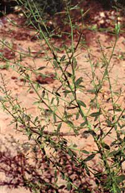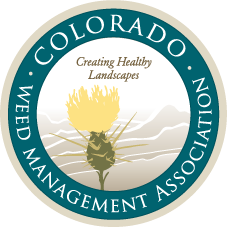Camelthorn
Alhagi pseudalhagi
a.k.a Alhagi maurorum Medik.
Keys to Identification
- Camelthorn is a member of the pea family. Introduced from Asia, it grows in dry or moist soils and can be found along streams and canals. Although it is not yet known to occur in Colorado, it has been found in New Mexico.
- Camelthorn is a spiny perennial shrub that grows from 1-1/2 to 4 feet tall. The greenish stems have slender spines 1/4 to 1-3/4 inches long. Single leaves are wedge-shaped and alternate. Flowers are small, pea-like, pinkish purple to maroon, occurring on short spine-tipped branches on the upper portion of the plant.
Family
Fabaceae (Pea)
USDA Code
ALPS3 – Alhagi pseudoalhagi (Beib.) Desv.
ALMA12 – Alhagi maurorum Medik.
Legal Status
Colorado List A Noxious Weed
Identification
Lifecycle
Perrenial
Growth form
Shrub. 1 1/2-4 ft tall
Flower
Pink (Caryophyllaceae)
Seeds/Fruit
Reddish brown pods are constricted and break apart between the seeds. 5-8 seeds per pod.
Leaves
Simple, small, alternate, leathery. Upper surface is yellow-green with small red dots. Undersides are blue-green and covered with hairs.
Stems
Spiny
Roots
Deep woody roots. Rhizomes may spread up to 40 ft horizontally.
Seedling
Seeds need to be buried under shallow soil or animal manure.
Impacts
Agricultural
Invades hay fields and rangeland reducing forage quantity and quality..
Ecological
May be spread by animals. Forms dense patches which will out-compete native vegetation.
Habitat and Distribution
General requirements
Prefers dry climates. Does best in areas of high fertility. Is deciduous in cold areas.
Distribution
Has been found in over 35 states.
Historical
Native to the Mediterranean region and to Asia. First found in North America around 1915. May have arrived as a contaminant in alfalfa seed.
Biology/Ecology
Mode of reproduction
Reproduces mainly by spreading rhizomes. Each rhizome produces many new shoots that then send down deep woody roots. Also by seed.
Seed production
700-4000 per plant under dry conditions. Lower under moist, shady conditions.
Seed bank
Seeds may last a number of years.
Dispersal
Animals. Spreading rhizomes. Wind and water.
References
USDA, NRCS. 2005. The PLANTS Database, Version 3.5 (http://plants.usda.gov). Data compiled from various sources by Mark W. Skinner. National Plant Data Center, Baton Rouge, LA 70874-4490 USA
Whitson, T.D.(ed.), L.C. Burrill, S.A. Dewey, D.W. Cudney, B.E. Nelson, R.D. Lee, R. Parker. 9th Edition 2000. Weeds of the West. Western Society of Weed Science, in cooperation with the Western United States Land Grant Universities Cooperative Extension Services, Newark CA.



